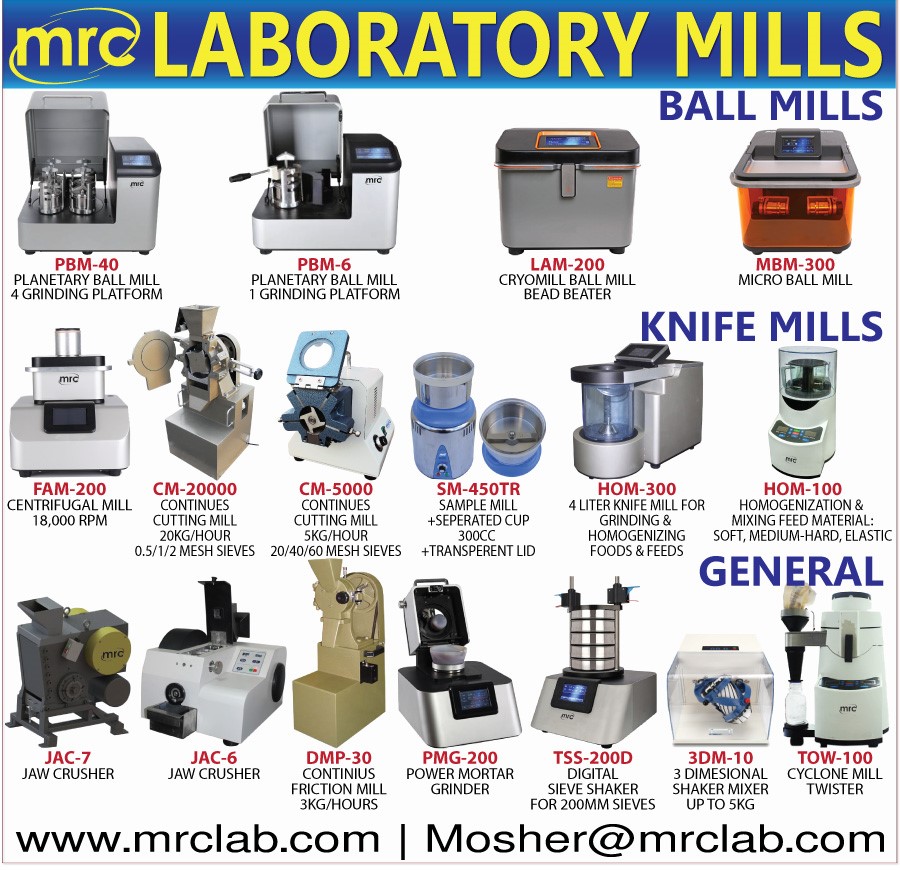A Lab grinding mill is a unit operation designed to break a solid material into smaller pieces. There are many different types of laboratory mills and grinding mills for lab and many types of materials processed in them. The grinding of solid matters occurs under exposure of mechanical forces that trench the structure by overcoming of the interior bonding forces. After the grinding the state of the solid is
changed: the grain size, the grain size disposition and the grain shape

Grinding is used to finish workpieces that must show high surface quality and high accuracy of shape and dimension.
For chemical and physical analytical methods it is essential that the specimen is perfectly homogenized to an adequate degree of analytical fineness.

MRC provides reliable range of grinders and mills for sample preparation, for coarse, fine and ultrafine size reduction of almost any dry material.
Milling also refers to the process of breaking down, separating, sizing, or classifying aggregate material. For instance rock crushing or grinding to produce uniform aggregate size for construction purposes, or separation of rock, soil or aggregate material for the purposes of structural fill or land reclamation activities. Aggregate milling processes are also used to remove or separate contamination or moisture from aggregate or soil and to produce "dry fills" prior to transport or structural filling.
Grinding may serve the following purposes in engineering:
- Increase of the surface area of a solid
- Manufacturing of a solid with a desired grain size
- Pulping of resources
A typical type of fine grinder is the ball mill. A slightly inclined or horizontal rotating cylinder is partially filled with balls, usually stone or metal, which grinds material to the necessary fineness by friction and impact with the tumbling balls. Ball mills normally operate with an approximate ball charge of 30%. Ball mills are characterized by their smaller (comparatively) diameter and longer length, and often have a length 1.5 to 2.5 times the diameter. The feed is at one end of the cylinder and the discharge is at the other.
Small versions of ball mills can be found in laboratories where they are used for grinding sample material for quality assurance.
Operation of a ball mill:
Laboratory Sample Mill
Sample Mill are designed for grinding particularly hard dry materials, they are similar to coffee grinders but they are more powerful and a larger and more powerful motor that does not burn with effort.
Applications of Sample Mill
These mills can be found in field service laboratories, agricultural laboratories, laboratories of building material manufacturers, pharmaceutical laboratories, seed laboratories, food laboratories and mixing institutes.
-The mills are designed for grinding trees, branches, leaf, seeds, spices, legumes, tablets, gravel, rocks, stones, ceramics electronic cards and memories, raw materials of the building, plastics and food industry and more.
Remarks:
- The particle size obtained after grinding is less than one hundred microns
In a sample grinder you can grind a very small amount, even of one leaf
Application of Lab grinding mill
Application of Lab grinding mill Is very wide:
To grind or homogenize wet,soft,brittle, elastic, hard,dry,and fibrous materials.
A lab grinding mill is used to grind a wide variety of materials into fine powders or smaller particle sizes for analysis or further processing. Common materials ground in lab grinding mills include:
Pharmaceuticals:
Active pharmaceutical ingredients (APIs), excipients, and other raw materials for drug formulations.
Chemicals:
Various chemicals and compounds used in research, development, and industrial processes.
Food Products:
Grains, spices, and other food ingredients for quality testing or to create uniform particle sizes for further use in food production.
Minerals and Ores:
Samples of rocks, minerals, and ores for geological analysis or extraction processes in the mining industry.
Biological Materials:
Plant and animal tissues, seeds, or bacteria for biological research or sample preparation.
Metals:
Certain types of metals, alloys, or metal powders, especially in material science research or for preparing metal powders used in industrial applications.
Ceramics and Glass:
Ceramics, glass, and other brittle materials for use in material science, quality control, or product development.
Plastics and Polymers:
Plastic materials, rubber, and polymers, often for recycling purposes or to test properties.
Soil and Sediments:
Soil samples and sediments are ground for environmental or agricultural testing.

Ball Mill Homogenizer
Ball Mill Homogenizers distinguish themselves by their unique design and operational principles. Unlike traditional homogenization methods, such as manual grinding or rotor-stator devices, ball mills leverage the energy generated by balls in a rotating chamber to homogenize samples. This dynamic approach ensures uniform particle size reduction, a critical factor in various scientific applications.